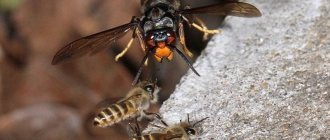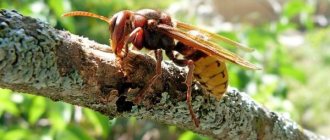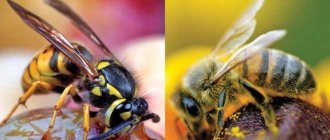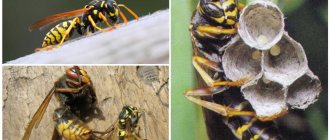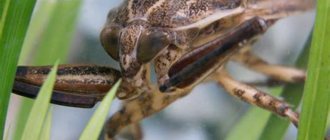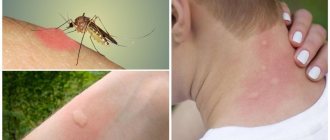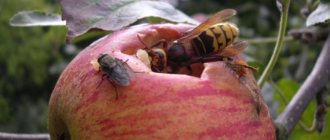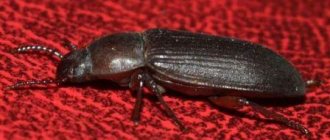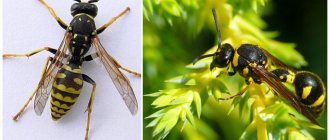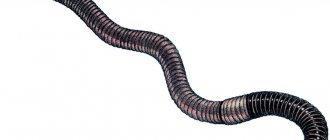Description and appearance
The Asian giant hornet (Latin name Vespa mandarinia) is the largest species of hornet on the planet. The wingspan of the insect reaches 8 cm, and the length of the sting is about 6 mm. In fact, the huge size is due to the habitat - the larger the body surface, the easier it is to tolerate the hot climate.
The body structure and coloration of the giant hornet is very similar to its relatives. But there are also differences, for example, a large, elongated head. The coloring is also different - the black stripes on the yellow body of the Asian hornet are wider, and the head is yellow or light orange.
Appearance
The secret weapon of Japanese bees
Bees against hornets have developed a unique method of dealing with uninvited guests. Their defense tactics are interesting - approximately 500 bees, having noticed the enemy, stick around him and create high temperatures around him; he can withstand no more than 47 ° C, while bees can withstand up to 50 ° C. This temperature regime is maintained thanks to the enhanced operation of the wings. The lack of oxygen and hot air do their job - the giant insect dies. This way, the bees kill the hornet before it releases fear pheromones.
Bees and hornets have long been adversaries, despite being related. After all, a bee hive for a hornet is valuable and nutritious meat for the larvae and food for the adults.
It is the embodiment of genuine horror and nightmare. Due to its size and very aggressive nature, it turned into a real monster, terrorizing residents. Perhaps someone will think that this is an exaggeration. Not at all. And the material presented below is able to prove the veracity of this statement.
Japanese hornet
The Japanese giant hornet is a subspecies of the Asian one. It lives only in Japan, where it is called the "sparrow bee." The color is brown-yellow, the size reaches 5.5 cm.
Japanese hornets are a real disaster for apiary owners. The fact is that Japanese beekeepers prefer to breed European bees, as it is more profitable. But this type of bee, unlike Japanese bees, is not adapted to withstand large predators, so hornets regularly attack apiaries, causing enormous damage.
The venom of huge Japanese hornets is considered one of the most toxic. According to statistics, up to 40 people die every year from the bites of these insects in the country.
Habitat
The homeland of this insect is Japan. Beyond its borders, the Japanese hornet lives exclusively in the southern part of Sakhalin Island. In Eurasia, its closest brother is the Asian hornet. On the territory of the Russian Federation, its habitat is the Primorsky Territory. This is where it is found most often.
The hornet's cocoon is very similar to a wasp's nest; it is distinguished from the latter by its exceptionally large size. If a person himself does not bother them, they will not attack him. They attack if they are in great danger. To get rid of nests, you should use the services of certified specialists. Otherwise, there is a high probability of being stung.
Lifestyle and nutrition of the Asian hornet
The Asian hornet's lifestyle is no different from other members of the genus. At the beginning of the warm season, the awakened queen begins to build a nest, then lays eggs in it. After the larvae appear, she provides them with food. When the first generation of working females grows up, they are engaged in building the nest and protecting it, obtaining food and feeding the larvae, the queen only lays eggs.
The diet of giant hornets is quite varied. It includes:
- insects;
- fruits;
- berries;
- nectar;
- meat;
- fish.
Larvae need protein food for growth and development. Interestingly, the Asian hornet practically does not use its sting when hunting. It kills prey with the help of its powerful jaws.
Aggressive disposition
Another negative feature is the aggressiveness of the hornet. In search of food, these creatures without a shadow of a doubt attack other insects, and sometimes even animals. Moreover, sensing danger, they immediately attack their offender for an hour. At the same time, they are not at all embarrassed by the fact that their enemy can surpass them both in size and in numbers.
It is because of its aggressive nature that the Japanese hornet has become a threat to these islands. Everyone tries to avoid him. After all, who knows what mood the “sparrow bee” is in today - will she want to “greet” her guests?
Bite symptoms
When a toxic substance enters the human body from the sting, it causes the following symptoms:
- severe burning pain;
- extensive swelling;
- redness of the skin.
In addition to the local reaction, a general deterioration in well-being is possible, which manifests itself:
- weakness, dizziness;
- headache;
- rapid heartbeat;
- shortness of breath, difficulty breathing;
- increased temperature, fever;
- enlarged lymph nodes.
Bite
In severe cases, convulsions, loss of consciousness, and suffocation are observed.
Why some people think hornets don't have stings
In a calm state, the hornets' sting is practically invisible and it is very difficult to notice it in this case. Since these insects have a protective color, which is an indicator of danger, hornets live without worries. They are not afraid of other insects, because representatives of this family are themselves predators. Hornets prey on flies, grasshoppers, praying mantises, mosquitoes and spiders. However, the greatest danger hornets pose is to honey bees. When attacking a hive, they can destroy almost the entire bee colony.
When hornets fly out to “hunt,” they use their powerful jaws to attack. They can even bite through human skin, leaving an itchy wound after the bite. If you have ever seen a hornet, then you probably remember what a huge head and eyes it has, as well as the sound its wings make.
Of course, hornets most often use a sting for defense and attack. Thanks to the special structure of the body, the sting can easily hide inside the muscles and extend in a matter of seconds in case of danger.
Actions when bitten
To alleviate the condition of a person who has been stung by an Asian hornet, the following measures must be taken:
- remove the victim from the scene of the attack;
- check if there is a sting left in the wound; if it is found, remove it using tweezers;
- rinse the wound with clean water;
- treat the affected area with an antiseptic;
- apply a cold compress to relieve swelling;
- apply a piece of wet sugar, which will help draw out the poison;
- Give the victim an antihistamine or injection.
The stung person should drink more clean water to quickly remove the poison from the body. If possible, you should visit a doctor, and if the condition worsens, this should be done as quickly as possible.
Storm of all bees
The huge hornet causes the most trouble to Japanese beekeepers. Honey bees (usually the European variety, which are more industrious and less aggressive) are a real delicacy for hornets. However, the prey is not only bees, but also the honey they produce, which the giant predator feasts on after the destruction of the hive.
This is interesting
A single giant hornet can kill up to thirty bees in a minute, and a group of 30-40 “aggressors” destroys a bee family of 20-25 thousand individuals in a few hours.
If a scout hornet finds a residential hive with bees, it leaves odorous marks near it, and upon returning to the nest, it shows its fellows the way to the delicacy. After this, the murder hornets set off as a whole squad to destroy the hive.
In fairness, it is worth noting that some species of bees, in turn, also have a unique mechanism for combating hornets. However, it gives results only with a small number of attackers. If the hornets attack in significant numbers, the bees, alas, are powerless.
So, how does the bees' defense mechanism work? The defense of the hive consists of several stages:
- at the very beginning, when the giant hornet tries to enter the hive, several bees surround it;
- then others sit on them, and this continues until a huge ball of bees, up to 30-35 cm in diameter, grows around the hornet;
- parallel to this process, all the defenders of the hive actively move their wings, directing the air inside the ball - towards the aggressor - and heating it to 46-47 ° C, which is destructive for the hornet (the bees themselves can withstand heating up to 50 ° C).
The result of all these efforts is the death of the attacking predator from overheating within about one hour.
Despite this seemingly effective mechanism, bees are not able to cope with an entire squad of winged killers. That is why the Japanese huge hornet is considered to be the cause of serious losses for beekeeping farms in this country. Owners and workers of apiaries are doing their best to destroy hornet nests near the locations of honey beehives.
It is also useful to read: First aid rules for hornet bites
However, the struggle of beekeepers against an enemy insect often ends in loss: a huge hornet, due to its size, can fly away in search of food up to 10 km from its nest, and pursue the victim itself up to 5 km. Therefore, despite all human efforts, destroying the nests of a giant predator often does not produce significant results in protecting apiaries.
How to avoid being bitten?
The same actions as its smaller relatives can provoke an attack by a large hornet. To avoid being bitten, just follow a few simple rules:
- when near an insect, you should not make sudden movements, even to drive it away;
- when going for a walk in an area where hornets are found, it is advisable to wear the most closed clothing in calm colors; you should not wear perfume;
- Having noticed a nest, you must slowly and calmly move away from it; it is extremely dangerous to approach it, touch it or try to destroy it.
It is strictly unacceptable to kill an Asian hornet near its nest. There is a high probability that other members of the colony will fly in to avenge him.
Vespa Mandarinia Japonica now
Human encounters with the Japanese hornet occur most often in the forested regions of the Japanese islands. Insects make their light gray nests in trees; you should never approach them. If people find a hive near their land, they call special teams to destroy the insects.
In recent decades, changes have been observed in the behavior and lifestyle of Japanese hornets, probably associated with climate change. So, they began to behave more aggressively: previously they attacked residents in rural areas who disturbed their hive, now there are cases of unmotivated insect attacks on people in cities.
There is no confirmed information about the expansion of the hornets’ habitat; the species still remains endemic to the Japanese Islands, outside Japan found only in the south of Sakhalin. Its close relative is widespread in Europe - the Asian huge hornet, also a dangerous and large insect.
How to destroy an Asian hornet nest?
Measures to control Asian hornets are similar to methods for getting rid of other varieties of hornets. The most effective way is to destroy the insect nest. The following methods are suitable for this:
- treat the nest with an insecticide (another option is to spray the drug into a bag, which you then put on the nest and tie tightly);
- pour flammable liquid over the hornets’ home and set it on fire;
- flood the nest (either fill it with water, or, if it is attached to the ceiling, bring a container of water, immerse the nest in liquid, holding the structure with the help of a substitute support).
Before you take any action, you must protect yourself by wearing a special suit, gloves, shoes and a hat with a net that covers your face.
Before starting the fight, it is necessary to take into account that the population of Asian hornets is constantly declining. Therefore, it is worth destroying their nests only if they are located near the house and the insects pose a real threat.
Safety rules for insect control
When carrying out activities aimed at combating hornets, it is necessary to adhere to the following safety measures:
- Wear overalls or clothing made of thick fabric that completely covers the entire body. The skin must be completely protected.
- It is better to protect your face with a bee mask that is used in apiaries.
- Protect your hands by wearing gloves made of thick fabric or rubber.
- You should definitely prepare a first aid kit. It should contain drugs against bites (hydrogen peroxide, alcohol), as well as drugs against allergic reactions - Suprastin, Dexamethasone.
- During work to destroy hornets, there should be no children, animals, or other unauthorized persons on the site. After all, the remaining hornets, noticing the loss of the nest, do not behave friendly at all.
- The nest should be destroyed at night or just before dawn, when insect activity is lowest. It is best to carry out the procedure for eliminating hornet homes in the spring, when the insect population is not so large.
- When there are already a lot of insects, it is better not to take risks and contact the appropriate sanitary services. The same should be done if you are not sure that you can get rid of them yourself.
The bite of a Japanese hornet is dangerous for allergy sufferers and others, as this type of insect has toxic poison.
The most dangerous are multiple bites and stings in the head or neck area. Timely assistance in all cases of bites should be provided immediately.
Sources:
https://7ogorod.ru/prochee/aponskij-sersen.html https://gdeklop.ru/osy-i-pchely/yaponskij-shershen/ https://fermer.blog/bok/pchelovodstvo/shershni/4343-japonskij -shershen.html
The danger of the poisonous substance found in the hornet's sting
The hornet is a thrifty insect that conserves its poison. With one hornet bite, only a small drop of poison enters the human body. However, if this is necessary and the hornet senses great danger, it can sting its victim again. This is probably why some people think that the hornet has more than one sting.
Many people wonder whether this insect has its sting in the body of the victim? The answer to this is clear: no. Since the insect's sting is thin and has a smooth structure, it can be easily pulled out from under the skin in a matter of seconds. In this case, the hornet can attack the enemy with the same sting again and again. Being in a panic, a person can kill a hornet. But if this representative of the wasp family manages to release “alarm” pheromones into the air, a person may be in serious danger. After all, the smell of these substances will attract relatives of the hornet, which can severely bite the enemy.
For humans, even one bite can be dangerous. The poison is especially dangerous for people prone to allergic reactions. After all, the poison contains the following toxic components:
- Acetylcholine is a transmitter of nervous excitation from the cells themselves to the muscles. It is because of its high concentration in the poison that a person experiences severe pain when bitten.
- Histamine is a substance that provokes a severe allergic reaction. In addition, it contains amino acids that enhance this reaction and accelerate its consequences.
- Phospholipases - this component destroys capillaries at the cellular level. As a result, bleeding and suppuration may appear in the affected area.
- Components that increase heartbeat. As a result, the pulse quickens and the poison begins to spread faster throughout the victim’s body.
To take off faster after being stung, hornets sting while bending over. They fly away and leave the enemy alone with his pain. The hornets do not leave the victim a single chance to retaliate.
If representatives of this family bite in some parts of the body, a person faces serious danger. For example, in the head, throat, chest, stomach or eyelid. Even if the victim is resistant to allergic reactions, the hornet's venom can cause severe swelling. Because of it, the airways and other vital organs can become compromised, leading to death.
Therefore, a person should not forget that the sting is a protected organ of the hornet. The poison from it can seriously harm the body and lead to serious consequences. To prevent being bitten, it is better to stay away from these insects.
Black hornet or Dybowski's hornet
This insect has a body length from 3.5 cm to 2.5 cm. It is similar in size to the European hornet, but its appearance is original: its abdomen is black, its wings are brown, and it has no stripes. Only in this species the queen does not build nests on her own.
Black hornet or Dybowski's hornet
It is a parasite, climbs into the nests of other hornets (common or oriental) and kills the hostess. After this, the entire swarm dies, and the raider takes over someone else’s nest. These hornets are common in India, China, and Japan. Their stings are poisonous, but the venom is less toxic than that of the Asian hornet. It feeds on insects, like all its relatives.
